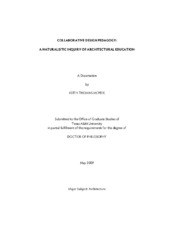| dc.description.abstract | This research examines interviews conducted with more than a dozen authorities in architectural education on collaborative methodologies utilized in the design studio and identifies factors that inhibit and facilitate the incorporation of collaborative methods in the context of situated learning. This research explores the notion that the design and implementation of even the simplest architectural projects are almost exclusively collaborative endeavors requiring the expertise of a spectrum of individuals working together to achieve a singular goal. Each of these experts is highly trained in their respective areas, yet few are formally trained authorities in the skills of collaboration, including architects, individuals who are often put at the lead of design projects which include people of varied backgrounds, working styles and areas of expertise.
Historically, the education of an architect has been a highly individualized pursuit, focused on the development of an individual skill set seldom requiring collaboration beyond that of student and professor. While this individualized, hands on approach to education has been highly revered by many, it often falls short of its potential and fails to recognize that the greatest design accomplishments of humankind have been the undertaking of collaborative enterprise. Furthermore, architecture students are being prepared in a manner that is contrary to the highly collaborative nature of the architectural practice they will enter without taking away from the inherent strengths of the traditional architectural education. Despite NAAB requirements for collaborative methods in the classroom, and an increasingly collaborative model of professional practice for architects, design education continues to trail woefully behind other disciplines such as business, law, nursing and medicine; each having long ago integrated collaborative study models into their curriculum. This research examines how collaborative methods including intradisciplinary, interdisciplinary and community based collaborations, can be further integrated as a formal part of the overall design curriculum and what factors facilitate and inhibit this inclusion. | en |


